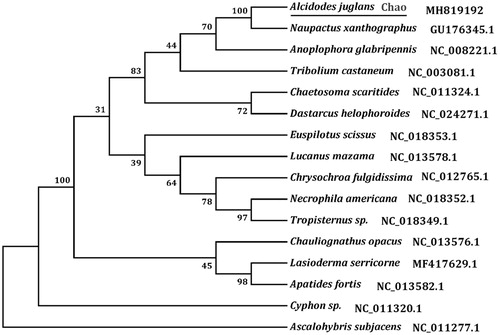Abstract
The walnut weevil, Alcidodes juglans Chao (Coleoptera: Curculionidae), is an important agricultural pest and distributed widely in China. The complete mitochondrial genome of A. juglans is 15,638 bp long, and consists of 13 protein-coding genes (PCGs), two ribosomal RNA genes, 21 transfer RNA (tRNA) genes and a putative control region (GenBank accession No. MH819192). The trnI gene has not been observed in the A. juglans mitogenome. The nucleotide composition is significantly biased (A, G, C, and T was 38.35%, 10.02%, 14.96%, and 36.67%, respectively) with A + T contents of 75.02%. All of the 21 tRNAs have the typical cloverleaf structure, with an exception for trnS1 (AGN). All PCGs are initiated by ATN codons, except for cox1 with AAT instead. Ten PCGs use a common stop codon of TAA or TAG, whereas the remaining three were terminated with a single T. The phylogenetic relationships based on neighbour-joining method showed that A. juglans is closely related to Naupactus xanthographus, which is in accordance with the traditional morphological classification.
The walnut weevil, Alcidodes juglans Chao (Coleoptera: Curculionidae), is an important agricultural pest and distributed widely in China. The larvae of A. juglans bore tunnels into the centre of fruits, and spend their larval stage inside host plants. It causes great economic losses in walnut cultivated areas (Liu and Feng Citation2014).The specimen of A. juglans used in this study were collected from Hezhang County, Guizhou Province, China (N27°05′, E104°37′), and deposited in the insect specimen room of Guiyang University with an accession number GYU-Col-20180001.
The complete mitogenome of A. juglans is a closed-circular molecule of 15,638 bp in length (GenBank accession No. MH819192), and containing the typical set of 13 protein-coding genes (PCGs), two ribosomal RNA genes (rrnL and rrnS), 21 transfer RNA genes (tRNAs), and a putative control region. The gene order and organization of A. juglans are consistent with those of putative ancestor of insects (Boore Citation1999). The trnI was not found in the A. juglans mitogenome, as observed in Sympiezomias velatus (Tang et al. Citation2017) and C. buqueti (Yang et al. Citation2018), two completely sequenced species in Coleoptera. The nucleotide composition of the mitogenome of A. juglans is significantly biased (A, G, C, and T was 38.35%, 10.02%, 14.96%, and 36.67%, respectively) with A + T contents of 75.02%. The AT-skew and GC-skew of this genome were 0.022 and −0.330, respectively. Fourteen genes were oriented on the N-strand, whereas the others were transcribed on the J-strand.
The A. juglans mitogenome harbours a total of 16 bp overlapping sequences in six regions. The longest overlap is 7 bp in length, and located between atp8 and atp6. This mitogenome has a total of 182 bp intergenic spacer sequences, which is made up of 14 regions in the range from 1 to 67 bp. The largest intergenic spacer sequence of 67 bp is located between trnS2 and nad1. The control region was located between rrnS and trnQ genes with a length of 803 bp, and the A + T content was 83.44%. With an exception for trnS1 (AGN), all tRNAs have the typical cloverleaf structure, which are similar to those reported in most animal mitogenomes (Wolstenholme Citation1992; Yuan et al. Citation2016). The length of these tRNAs ranged from 63 bp (trnT and trnE) to 71 bp (trnK), A + T content ranged from 59.42% (trnR) to 90.91% (trnD). Two rRNAs (rrnL and rrnS) are located between trnL1 and trnV, and between trnV and the control region, respectively. The rrnL was 1323 bp in length with A + T content of 77.63%, and the rrnS was 789 bp in length with A + T content of 73.26%.
The initial codons for 12 PCGs of A. juglans were the canonical putative start codons ATN (ATG for atp6, cox3, nad4L, and cob; ATT for nad3, nad5, nad6, and nad2; ATA for atp8, nad4, and nad1; ATC for cox2). However, cox1 used AAT as start codon, as observed in Tribolium castanum (Liu et al. Citation2014), another completely sequenced species in Coleoptera. The typical termination codon (TAA or TAG) occurs in 10 PCGs, and the remaining PCGs including cox1, cox2, and nad5 were terminated with a single T. Based on the concatenated amino acid sequences of 13 PCGs, the neighbour-joining method was used to construct the phylogenetic relationship of A. juglans with 14 other bettles. The result showed that A. juglans is closely related to Naupactus xanthographus (), which is in accordance with the traditional morphological classification.
Disclosure statement
The authors report no conflicts of interests. The authors alone are responsible for the content and writing of the paper.
Additional information
Funding
References
- Boore JL. 1999. Survey and summary: animal mitochondrial genomes. Nucleic Acids Res. 27:1767–1780.
- Liu CH, Feng LM. 2014. Reasons analysis on severer harms by Alcidodes juglans Chao. Shanxi Forest Sci Technol. 1:84–86.
- Liu QN, Bian DD, Jiang SH, Li ZX, Ge BM, Xuan FJ, Yang L, Li FC, Zhang DZ, Zhou CL, Tang BP. 2014. The complete mitochondrial genome of the red flour beetle, Tribolium castaneum (Coleoptera: Tenebrionidae). Mitochondrial DNA. 10:1–3.
- Wolstenholme DR. 1992. Animal mitochondrial DNA: structure and evolution. Int Rev Cytol. 141:173–216.
- Tang PA, Zhang L, Li XP, Li FF, Yuan ML. 2017. The complete mitogenome of Sympiezomias velatus (Coleoptera: Curculionidae). Mitochondrial DNA Part B. 2:449–450.
- Yang WJ, Yang DX, Xu KK, Cao Y, Meng YL, Wu Y, Li GY, Zhang GZ, Wang YW, Li C. 2018. Complete mitochondrial genome of the bamboo snout beetle, Cyrotrachelus buqueti (Coleoptera: Curculionidae). Mitochondrial DNA Part B. 3:88–89.
- Yuan ML, Zhang QL, Zhang L, Guo ZL, Liu YJ, Shen YY, Shao RF. 2016. High-level phylogeny of the Coleoptera inferred with mitochondrial genome sequences. Mol Phylogenet Evol. 104:99–111.

